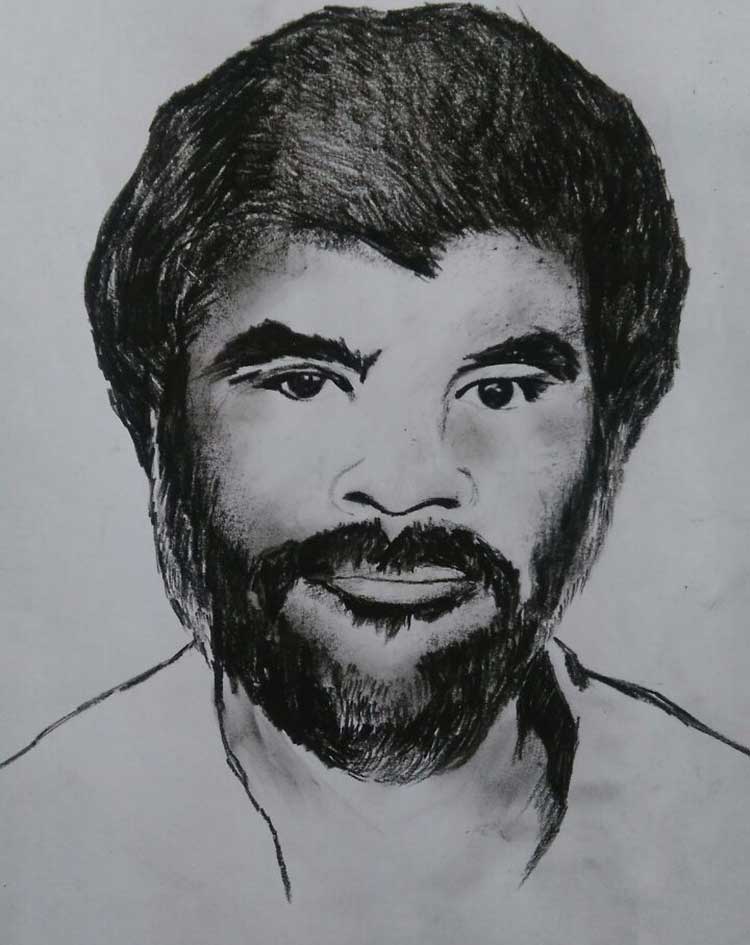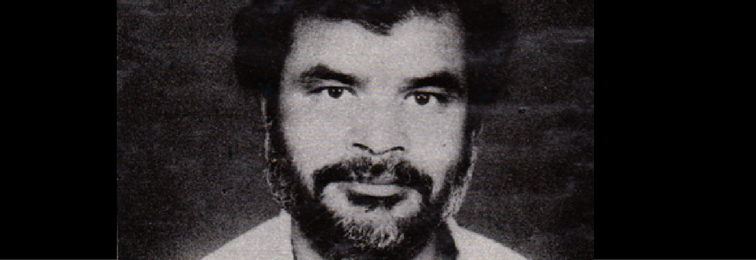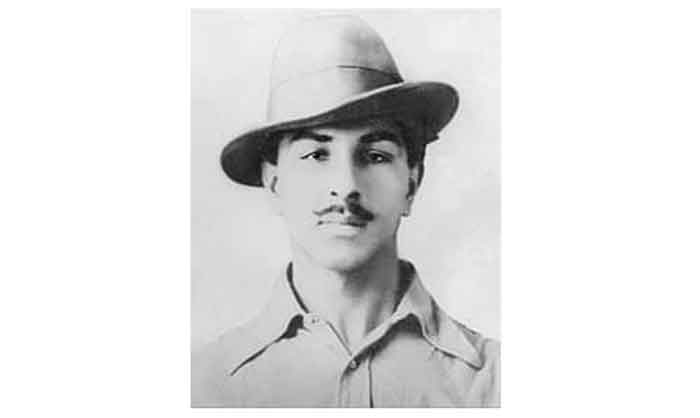Asim Das, Indradeb Choudhury, Kishori Choudhury, Kumar Verma, K. N. Pradip Kutty, Keshav Prasad Gupta, Joga Jadav, Dhirpal Sinha, Puranik Pal, Prem Narayan, Madhukar Choudhury, Manoharan Verma, Ramkripal Misra, Ramajna Chauhan, Lashman Verma, Hiru Ram
“The butchers that murdered you will be judged in the tribunal of today. We will not let the killers be the arbiters of justice in your murder. We will fight, we will struggle, we will win, our court will give the assassins a sentence – a death sentence.”—From the Shaheed Memorial of Dalli-Rajhara
At 9 a.m. on July 1st, 1992, the agitating workers of Bhilai, Urla, Tedesara and Kumhari, under the direction of the president of the Chhattisgarh Mukti Morcha, Janaklal Thakur, started moving from the Sector I maidan towards the Bhilai power house station. As they neared the railway line, two trains approached from opposing directions. The trains were allowed to pass without obstruction. Then the sit-in on the railway line began. This sit-in was in support of the workers’ nine-point demand. It was undertaken after the three-party negotiations broke down multiple times and the employers stayed away from the last scheduled meeting on June 30th.
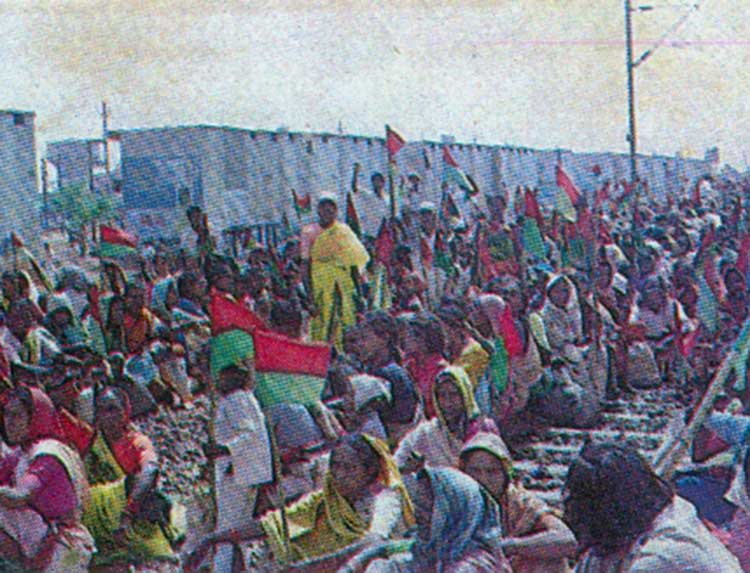
The workers sat peacefully on the railway line chanting slogans and singing protest songs. A massive police force arrived at 1 p.m. The officers asked people to leave the railway line. The workers stood firm and refused. Their demand was simple – they would leave the railway line if the employers signed the draft agreement that was drawn up in February 1992 by the three District Collectors, the Police Superintendent and the Divisional Commissioner, an agreement which stipulated that those out of work would be reinstated in two phases.
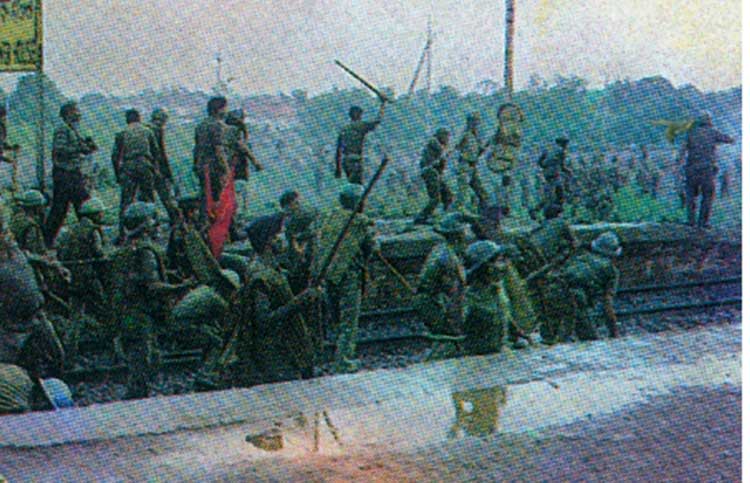
Around 4 pm, the police force surrounded the agitators and started firing tear gas. When the workers remained unmoved, they began a lathi charge and started throwing stones. The workers also threw stones to defend themselves and angry bystanders attacked the police. Around 6 pm bullets were fired.
Fifteen people fell to the bullets – eleven members of the CMM, four non-members. (The sixteenth martyr was Dhirpal who survived gunshot wounds that day but died during surgery on 18th January, 1993.) More than a hundred men, women and children were injured. A sub-inspector of police also lost his life in the violence of that day.
The background of the violence
The Bhilai workers’ campaign started in September 1990. The movement was not limited to Bhilai in Durg district but spread far and wide to Riwagahan and Tedesara in Rajnandgaon district, Durg, Bhilai and Kumhari in Durg district, as well as Urla, Mahasamund and Baloda Bazar in Raipur district.
The workers left the collaborator unions (AITUC in some factories, INTUC or CITU in others) and built new organizations such as the Pragatisheel Engineering Shramik Sangh, Pragatisheel Cement Shramik Sangh, and Chhattisgarh Chemical Mill Mazdoor Sangh. The movement fanned out to the engineering, distillery, chemical and cement industries. In just one city, Bhilai, 32 factories formed new unions.
Foremost among the nine-point demands of the workers were (1) secure jobs in established factories (more than 90% of the workers in these factories were on contract), (2) a livable wage, (3) reinstatement of workers who were dismissed for being union members (i.e. the right to organize).
Aggression of the ruling class
On the surface, the demands were simple and in keeping with the labour laws of the country. But the ruling class understood the import of these demands.
Chhattisgarh was a land rich in mineral, forest and water resources. On top of that the simple, guileless people of Chhattisgarh provided a source of inexpensive labour. This region became the hunting ground for Indian and foreign companies wanting to make a killing and new industries sprouted everywhere. Accepting the demand for stable jobs, sufficient pay and the right to organize meant drying up the source of cheap labour.
As a result, while the workers organized beyond the confines of their factories, the owners also organized themselves in area-wide industrial associations. If a factory was under strike, other factories took up the task of filling their orders. In addition, the police machinery, state and central governments, and practically all ruling class parties gave their open support to the employers.
The police and their thugs began a reign of terror. People were imprisoned under false charges and more than 4200 workers were dismissed. Shankar Guha Niyogi, the life force of the Chhattisgarh Mukti Morcha, was jailed for two months. When he appealed to the High Court and was given bail, there were immediate attempts to ban him from five districts in Chhattisgarh. When this process was halted by the intervention of the High Court, a secret assassin hired by the employers murdered him on September 28th 1991.
After Niyogi’s killing
After Comrade Niyogi became a martyr to the class struggle, a nine-member central committee took charge of the organization and the movement. This group consisted of five labour leaders, one youth leader and three intellectuals.
Despite being a member of this committee, I must admit that the leadership after Niyogi lacked the farsightedness and the unshakeable confidence in proletarian internationalism that made Niyogi a successful leader of popular movements.
The nationwide outpouring of support that followed Niyogi’s murder was not effectively harnessed to put a dent in production. After Niyogi was killed, the workers went on a spontaneous strike. But the strike was withdrawn after seven days at the direction of the leaders. Instead, there were gatherings, meetings, marches, fasts, sit-ins, movements to fill the jails and other consciousness-raising activities.
The workers wanted to intensify the agitation and, as a result, some plans were announced – the November 15th encirclement of Nehru Nagar, the area where the employers lived, an indefinite movement to fill the jails beginning November 20th, blocking Murli Manohar Joshi’s Ekta Yatra on December 26th and direct action on 26th January 1993. But although the workers were ready to fight, time after time the leadership cancelled the plans based on promises from the authorities.
The great struggle
When the leadership was at a loss and the workers were about to take some self-injurious step in desperation, a new programme appeared. The direction for this came from a speech Com. Niyogi gave in Raipur in 1990. It was adapted to the current situation by a helpful friend from the CMM itself.
The top leadership, the leaders among the workers and the workers themselves discussed the proposed plan. The workers realized that worker power alone would not bring the Bhilai campaign to fruition, all allies would have to come together. After all, the demands of the Bhilai agitation were consequential not just for the agitating workers but for all working people of Chhattisgarh. A democratic decision was taken to assemble five lakh people, workers, farmers, youth, intellectuals, in Bhilai and carry out a shutdown of the city. Roads, railway lines, offices and factories would be silenced until the demands were met.
After extensive preparation, 29 groups of workers, with 25-30 people in each group, set out on 28th March with posters, badges and leaflets to broadcast their call to action. Over fifteen days, they took their message to almost 4000 villages in five districts. Thousands of villagers and workers in industrial areas signed up to be volunteers for a Bhilai shutdown. The Bhilai workers movement was transformed into a movement for the people’s development in Chhattisgarh.
25th May was declared the day of the Bhilai shutdown.
Cancellation of the shutdown programme
The shutdown plan drawn up by the workers through considerable discussion had become the people’s agenda after a widespread programme of dissemination. It was not just the people of Chhattisgarh that were involved. Patriotic and democracy-loving people from other states also raised lakhs of rupees for the campaign coffers.
Large numbers of police were stationed in places from which the volunteers were to come; there were attempts to intimidate. The industry minister of that time, Kailash Joshi, came armed with sweet words. He promised that the workers’ problems would be solved without delay. Believing these promises, the two main leaders of the Mukti Morcha called off the shutdown despite the objection of other members of the central committee and against the will of ordinary workers.
25th May
Despite the withdrawal of the planned shutdown, almost 50,000 workers and farmers gathered in Bhilai that day. Many leading supporters of the movement came from different parts of the country.
When the date of the shutdown was set, people did not realize that 25th May 1992 was the twenty-fifth anniversary of the Naxalbari uprising. A few days before 25th May, a CPI(ML) group started putting up posters in Bhilai as in the rest of the country. There were concerns that Naxals may infiltrate the group and incite people to violence. As a result, not even a procession was taken out on 25th May with 50,000 people as a show of strength.
There was a half-hearted meeting. People from the villages returned disappointed. Even though the workers were discouraged, they stood firm in their resolve that after such a long struggle and intense preparation they would not go back home without having their demands met.
Five thousand workers with their families began a sit-in at the Jamul Ravanbhata ground.
Failure of the three-party talks
The main demand of the workers was the reinstatement of those fired from their jobs for being union members. Several meetings were held on this issue at Durg, Raipur and finally at Indore, the main office of the Madhya Pradesh labour department. When faced with the possibility of a shutdown in Bhilai, the owners had talked about taking back the dismissed workers in two phases. In Indore they changed their tune. They agreed to take back only 500 of the 4200 workers and give them “alternate work” for “humanitarian reasons”. The worker representatives turned down this proposal in disgust.
Meanwhile, the workers changed the location of their sit-in, first from Jamul Ravanbhata to Sharada pada Baikunthanagar, from there to Chhauni, and from Chhauni to the Sector 1 maidan right next to the railway line. Brushing aside the intense heat of May-June and the occasional thunderstorm, they sat under the open sky day after day.
The failure of the three-party talks led to widespread dejection and the number of protesters slowly dwindled. The funds of the Mukti Morcha began to run out with expenses as high as Rs.20,000 per day. But the remaining workers refused to return empty-handed.
These were the circumstances in which the talks with Bhilai Works failed on June 29th and the employers’ representative did not appear at the June 30th meeting called by the labour department. On the night of June 30th, the leaders took the decision to shut down the railway line.
On July 1st, following in the footsteps of Com. Niyogi, 15 workers made the supreme sacrifice. The martyrs had their leader in Com. Keshav Prasad Gupta. He was the leader of the Pragatisheel Transport Shramik Sangh, an organization of contract transport workers of ACC, the first organization in Bhilai from this phase of the Chhattisgarh Mukti Morcha.
After the shooting
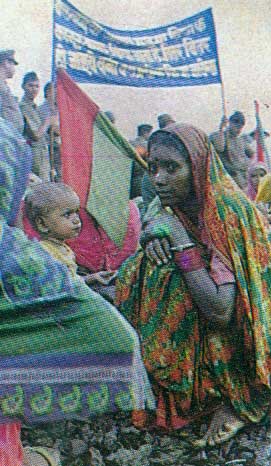 After the shooting, the white terror of the ruling class became more intense. A curfew was imposed for a week and section 144 was put in place for two and a half months. Apart from the two doctor members of the central committee, the others were forced to go into hiding. More than a hundred workers and their leaders, including three members of the central committee, were arrested on various charges. Three labour leaders were imprisoned without trial for eighteen months on the false charge of murdering the sub-inspector who was killed on July 1st.
After the shooting, the white terror of the ruling class became more intense. A curfew was imposed for a week and section 144 was put in place for two and a half months. Apart from the two doctor members of the central committee, the others were forced to go into hiding. More than a hundred workers and their leaders, including three members of the central committee, were arrested on various charges. Three labour leaders were imprisoned without trial for eighteen months on the false charge of murdering the sub-inspector who was killed on July 1st.
Despite this, the workers spontaneously went on strike for a week in the factories; although the strike was withdrawn at the direction of the leadership. The second rank leaders rapidly set up a democratic decision-making body and took charge of the organization in Bhilai. Through their efforts, more than 10,000 people gathered at an all-party meeting on July 15th while section 144 was still in force, there was a protest meeting in Bhopal on September 3rd, the authorities were compelled to withdraw section 144 on 15th September, and on 28th September, the anniversary of Niyogiji’s martyrdom, there was a huge demonstration of “people power over brute strength”.
The indecisiveness of the leaders
The vacillation of the leadership, evident before 25th May, became even stronger after the shooting. Instead of intensifying the class struggle, the leaders leaned towards solving problems through debate and discussion. When the workers pushed for an agitation, most of the leaders tried to subdue them by stoking fears of violent retaliation. There was also an ideological struggle within the organization between democratic and bureaucratic methods. In the end, the Chhattisgarh Mukti Morcha fell apart two years after the shooting. But that is a different story. It does not belong here with our remembrance of Shaheed Divas.
The Bhilai shooting could have been avoided
With full respect for the great self-sacrifice of the martyrs at Bhilai, I would say this – human life is precious, it should not be risked unless it is absolutely necessary.
- If the railway shutdown had been carried out with the kind of preparation made for 25th May, the police would not have had a chance to lift their guns. Even if we forget the expected 5 lakh people, just the 50,000 people that assembled on that day would have been enough to win victory without bloodshed.
- When the three-party talks started failing after 25th May, the second rank leaders strongly recommended going back to the villages to gather strength and strike back at Bhilai with force. The top leaders rejected this proposal with various excuses.
- The day and time of the railway line shutdown was not decided by favorable conditions on the ground but by the depleted state of the Mukti Morcha funds.
- The shooting could have been avoided even after the railway shutdown began if the other branches of the Mukti Morcha had begun simultaneous rail shutdowns in their areas. Then the police would not have been able to concentrate all of their repressive force on Bhilai. It must be mentioned here that, apart from Dalli-Rajhara, all main centres of the Mukti Morcha were located next to railway lines, from Chandi Dungri at the Maharashtra border to Rajnandgaon, Tedesara, Durg, Bhilai, Purena, Kumhari, Urla, Raipur, Baloda Bazar, Hirri, Champa, and Baradwar. At all these places, the local organizers were waiting for instructions from the leadership.
What should have been done after the shooting
There was no need to look anywhere else, an example was close at hand in the experience of the first organization of the Chhattisgarh Mukti Morcha. On 2-3 June 1977, 11 people from Dalli-Rajhara were martyred when police fired on workers protesting Niyogi’s arrest. After that, the mine workers struck work continuously for 19 days, forced Niyogi’s release from jail and won their other demands. The same thing could have been done at Bhilai, especially since the workers went on strike spontaneously for 7 days.
The lessons of Shaheed Divas and the Bhilai campaign
The Bhilai movement is now a shadow of its former self. But will the blood shed by Niyogi and the other 16 martyrs be in vain? We can truly honor the sacrifice of the martyrs only if we commit to understanding the history of the Bhilai movement and its failures and to applying that learning to mass movements.
Learning from the successes
- The Bhilai movement shows us how workers are tempered to steel in the fire of the class struggle.
- The Bhilai movement shows us how to organize allied forces alongside the workers’ struggle, how a workers’ campaign can be transformed into a movement for people’s rights in a large region.
- The Bhilai movement was only successful at those times when the movement agenda was set within the organization in a democratic manner. This teaches us that, in a mass organization, internal democracy is crucial.
- Niyogi’s self-sacrifice and the steadfastness until the end of the workers on the railway line, even in the face of bullets, teaches us to be courageous.
Learning from the failures
Some of the lessons learned from various events, I have mentioned earlier.
- Such a massive movement was extinguished because of the indecisiveness of the leadership following Niyogi. That is why, in addition to class struggle, the development of political consciousness among workers is very important.
- The Bhilai movement reminds us again that class struggle and not class compromise is the way to gain just demands.
- We learn that if bureaucratic methods are used instead of democratic centralism, the organization and movement dies a painful death.
- The blood of the July 1st martyrs reminds us not to be taken in by the promises of the ruling class.
- The days after the shooting remind us not to withdraw actions in fear of white terror but to confront intimidation with a tidal wave of popular democracy.
- The shooting reminds us that dealing with the ruling class without appropriate preparation is tantamount to suicide.
Last words
The workers of Bhilai have been disheartened by the slowness of the movement, the vacillation of the leaders after Niyogi, and the breakup of the organization. Employers in the factories have intensified their oppression.
Will the blood of the martyrs then be in vain?
Not so. As oppression grows, the workers of Bhilai will organize again and will jump again into the arena of struggle. This time, they will be armed with the lessons of Com. Niyogi and the lessons from the successes and failures of the Bhilai movement. This time they will be invincible and nothing can hold back their victory.

